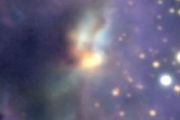Viewings: 4389

Even Herschel discovered on the background of the milky Way dark failures, which he called "holes in heaven". At the end of the XIX century on Litskai Observatory (USA) astronomer Edward Bar-backgammon began systematic sky photography. By 1913 he found about 200 dark nebulae. In his opinion, they were clouds absorbing light matter, and not the spaces between the stars, as did Herschel.
This supposition was confirmed. When near the cloud of interstellar gas or inside it there is no hot stars, gas is still cold and no light. If the cloud contained only gas, it would not notice. But in addition to the gas in the interstellar medium in a small amount (about 1% by mass, there are small particles of dust particle sizes of about 1 micron or less, which absorb light of distant stars. Why cold cloud and seems dark "failure in heaven". A detailed study of the milky Way has shown that very often, these "failures" found in regions of star formation, like the Orion nebula.
In 1946, the American astronomer Bart Bok found on the background of the bright nebula NGC 2237 in the Unicorn and NGC 6611 to Shield small black spots that are called globules. Their size from 0.01 to 1 PC. They weaken the light behind them stars in tens and hundreds times. This means that the substance of globules thousands of times denser than the surrounding gas. Their mass is estimated to range from 0.01 to 100 Solar masses.
After the opening of the globules appeared belief that shrinking clouds dozvedet matter already found that they are the direct predecessors of the stars. But it soon became obvious haste such a conclusion.
The fact that optical telescopes not provide a full picture of the interstellar medium: with their help, we find only hot clouds heated massive stars (like the Orion nebula), or small dark globules on a light background. Both are quite few of education. Created only in the 50's. radio telescopes have allowed to detect the radiation in line 21 cm atomic hydrogen filling up almost all the space between stars.
This is a very rarefied gas: about one atom per cubic centimeter of space (by the standards of the earth's laboratories - high vacuum!) But since the size of the Galaxy is huge, it recruited about 8 billion solar masses of interstellar gas, or approximately 5% of its total mass. Interstellar gas by more than 67% (by weight) consists of hydrogen, 28% helium, and less than 5% - for all other elements, the most abundant among them oxygen, carbon and nitrogen.
Especially a lot of interstellar gas near the plane of the Galaxy. Almost all of it is concentrated in a layer thickness of 600 light-years in diameter about 30 PDA, or 100 thousand light-years (it is the diameter of the galactic disk). But in this thin layer of gas is distributed unevenly. He concentrates in spiral branches of the Galaxy, and there is broken into large clouds length in parzecki and even tens of parsecs, and weighing hundreds of thousands of Solar masses. The density of the gas in which about 100 atoms per cubic centimeter, the temperature of about -200 °C. it Appeared that the critical mass and radius of jeans under such conditions, almost coincide with the mass and radius of the clouds, and this means that they are ready to collapse. But the most important discovery was yet to come.
Astronomers suspected that at relatively high density and low temperatures that prevail in interstellar clouds, part of the substance must unite in molecules. In this case, the most important part of the interstellar medium is not available to the observations in the optical range.
Beginning in 1970, ultraviolet observations with rockets and satellites allowed to open the main molecule interstellar hydrogen molecule (H2). And when observed interstellar space radio telescopes centimeter and millimeter were found dozens of other molecules, sometimes rather complex, containing up to 13 atoms. Among them are the molecules of water, ammonia, formaldehyde, ethanol, and even the amino acid glycine.
As it turned out, nearly half of interstellar gas contained in molecular clouds. Their density in hundreds times more, than clouds of atomic hydrogen, and the temperature of only a few degrees above absolute zero. Under such conditions arise unstable to gravitational compression of individual seals in the cloud mass around the mass of the Sun and makes possible the formation of stars.
Most of the molecular clouds registered only for the radio emission. Some, however, have long been known to astronomers, for example dark nebulae Coal Bag, highly visible eye in the southern part of the milky Way. The diameter of this cloud of 12 PC, but it looks great, because removed from us just 150 PC. Its mass is about 5 thousand solar masses, while some clouds reaching million solar, and size 60 PCs In such giant molecular clouds (in the Galaxy a few thousand) and are the main foci of the formation of stars.
















